Self-Saturable Absorption and Reverse-Saturable Absorption Effects in Diamond-Like Carbon Films with Embedded Copper Nanoparticles
Abstract
:1. Introduction
2. Materials and Methods
3. Results
3.1. Composition
3.2. Morphology and Structure
3.3. Linear Optical Properties
3.4. Nonlinear Optical Properties: Saturable Absorption and Reverse-Saturable Absorption
4. Discussion
5. Conclusions
Author Contributions
Funding
Acknowledgments
Conflicts of Interest
References
- Fibre Lasers Focus issue. Nat. Photonics 2013, 7, 841–932. [CrossRef]
- Nishizawa, N. Wideband ultrafast fiber laser sources for OCT and metrology. J. Phys. B At. Mol. Opt. Phys. 2016, 49, 182003. [Google Scholar] [CrossRef]
- Chan, C.-W.; Carson, L.; Smith, G.C.; Morelli, A.; Lee, S. Enhancing the antibacterial performance of orthopaedic implant materials by fibre laser surface engineering. Appl. Surf. Sci. 2017, 404, 67–81. [Google Scholar] [CrossRef] [Green Version]
- Hader, J.; Yang, H.-J.; Scheller, M.; Moloney, J.V.; Koch, S.W. Microscopic analysis of saturable absorbers: Semiconductor saturable absorber mirrors versus graphene. J. Appl. Phys. 2016, 119, 053102. [Google Scholar] [CrossRef]
- Ahmad, H.; Ruslan, N.E.; Ismail, M.A.; Ali, Z.A.; Reduan, S.A.; Lee, C.S.J.; Harun, S.W. Silver nanoparticle-film based saturable absorber for passively Q-switched erbium-doped fiber laser (EDFL) in ring cavity configuration. Laser Phys. 2016, 26, 095103. [Google Scholar] [CrossRef]
- Kang, Z.; Li, Q.; Gao, X.J.; Zhang, L.; Jia, Z.X.; Feng, Y.; Qin, G.S.; Qin, W.P. Gold nanorod saturable absorber for passive mode-locking at 1 μm wavelength. Laser Phys. Lett. 2014, 11, 035102. [Google Scholar] [CrossRef]
- Elim, H.I.; Yang, J.; Lee, J.-Y.; Mi, J.; Ji, W. Observation of saturable and reverse-saturable absorption at longitudinal surface plasmon resonance in gold nanorods. Appl. Phys. Lett. 2006, 88, 083107. [Google Scholar] [CrossRef] [Green Version]
- Kang, Z.; Guo, X.; Jia, Z.; Xu, Y.; Liu, L.; Zhao, D.; Qin, G.; Qin, W. Gold nanorods as saturable absorbers for all fiber passively Q-switched erbium-doped fiber laser. Opt. Mater. Express 2013, 3, 1986–1991. [Google Scholar] [CrossRef]
- Zheng, C.; Du, Y.; Feng, M.; Zhan, H. Shape dependence of nonlinear optical behaviors of nanostructured silver and their silica gel glass composites. Appl. Phys. Lett. 2008, 93, 143108. [Google Scholar] [CrossRef]
- Jiang, T.; Xu, Y.; Tian, Q.; Liu, L.; Kang, Z.; Yang, R.; Qin, G.; Qin, W. Passively Q-switching induced by gold nanocrystals. Appl. Phys. Lett. 2012, 101, 151122. [Google Scholar] [CrossRef]
- Nigoghossian, K.; dos Santos, M.V.; Barud, H.S.; da Silva, R.R.; Rocha, L.A.; Caiut, J.M.A.; de Assunção, R.M.N.; Spanhel, L.; Poulain, M.; Messaddeq, Y.; et al. Orange pectin mediated growth and stability of aqueous gold and silver nanocolloids. Appl. Surf. Sci. 2015, 341, 28–36. [Google Scholar] [CrossRef] [Green Version]
- Tamulevičius, S.; Meškinis, Š.; Tamulevičius, T.; Rubahn, H.-G. Diamond like carbon nanocomposites with embedded metallic nanoparticles. Rep. Prog. Phys. 2018, 81, 024501. [Google Scholar] [CrossRef] [PubMed] [Green Version]
- Ghosh, B.; Chakraborty, P.; Singh, B.P.; Kundu, T. Enhanced nonlinear optical responses in metal–glass nanocomposites. Appl. Surf. Sci. 2009, 256, 389–394. [Google Scholar] [CrossRef]
- Wu, D. Saturable Absorption of Copper Nanowires in Visible Regions for Short-Pulse Generation. IEEE Photonics J. 2016, 8, 4501507. [Google Scholar] [CrossRef]
- Muhammad, A.R.; Ahmad, M.T.; Zakaria, R.; Rahim, H.R.A.; Yusoff, S.F.A.Z.; Hamdan, K.S.; Yusof, H.H.M.; Arof, H.; Harun, S.W. Q-Switching Pulse Operation in 1.5-µm Region Using Copper Nanoparticles as Saturable Absorber. Chin. Phys. Lett. 2017, 34, 034205. [Google Scholar] [CrossRef]
- Philip, R.; Chantharasupawong, P.; Qian, H.; Jin, R.; Thomas, J. Evolution of Nonlinear Optical Properties: From Gold Atomic Clusters to Plasmonic Nanocrystals. Nano Lett. 2012, 12, 4661–4667. [Google Scholar] [CrossRef] [PubMed]
- Yadav, R.K.; Aneesh, J.; Sharma, R.; Abhiramnath, P.; Maji, T.K.; Ji Omar, G.; Mishra, A.K.; Karmakar, D.; Adarsh, K.V. Designing Hybrids of Graphene Oxide and Gold Nanoparticles for Nonlinear Optical Response. Phys. Rev. Appl. 2018, 9, 044043. [Google Scholar] [CrossRef] [Green Version]
- Gurudas, U.; Brooks, E.; Bubb, D.M.; Heiroth, S.; Lippert, T.; Wokaun, A. Saturable and reverse saturable absorption in silver nanodots at 532 nm using picosecond laser pulses. J. Appl. Phys. 2008, 104, 073107. [Google Scholar] [CrossRef]
- Ganeev, R.A.; Ryasnyansky, A.I.; Stepanov, A.L.; Usmanov, T. Characterization of nonlinear optical parameters of copper- and silver-doped silica glasses at λ = 1064 nm. Phys. Stat. Sol. 2004, 241, 935–944. [Google Scholar] [CrossRef]
- Dhanya, N.P. Non linear optical investigations of silver nanoparticles synthesised by curcumin reduction. Opt. Mater. 2017, 73, 384–387. [Google Scholar] [CrossRef]
- Dadhich, B.K.; Kumar, I.; Choubey, R.K.; Bhushan, B.; Priyam, A. Shape and size dependent nonlinear refraction and absorption in citrate-stabilized, near-IR plasmonic silver nanopyramids. Photochem. Photobiol. Sci. 2017, 16, 1556–1562. [Google Scholar] [CrossRef] [PubMed]
- Zasedatelev, A.; Dubinina, T.; Krasovskii, V.; Suprunova, O.; Tomilova, L.; Chistyakov, A. Resonant plasmon-stimulated nonlinear absorption in three-level systems. J. Phys. Conf. Ser. 2015, 643, 012049. [Google Scholar] [CrossRef]
- Robertson, J. Diamond-like amorphous carbon. Mater. Sci. Eng. R 2002, 37, 129–281. [Google Scholar] [CrossRef] [Green Version]
- Chen, S.-Y.; Ou, K.-L.; Huang, W.-C.; Chu, K.-T.; Ou, S.-F. Phase transformation of diamond-like carbon/silver composite films by sputtering deposition. Ceram. Int. 2013, 39, 2575–2580. [Google Scholar] [CrossRef]
- Cheng, C.-H.; Lin, Y.; Chen, T.; Chen, H.; Chi, Y.; Lee, C.; Wu, C.; Lin, G. Can silicon carbide serve as a saturable absorber for passive mode-locked fiber lasers? Sci. Rep. 2016, 5, 16463. [Google Scholar] [CrossRef] [PubMed]
- Meškinis, Š.; Kopustinskas, V.; Tamulevičienė, A.; Tamulevičius, S.; Niaura, G.; Jankauskas, J.; Gudaitis, R. Ion beam energy effects on structure and properties of diamond like carbon films deposited by closed drift ion source. Vacuum 2010, 84, 1133–1137. [Google Scholar] [CrossRef]
- Ferrari, A.C.; Robertson, J. Raman spectroscopy of amorphous, nanostructured, diamond–like carbon, and nanodiamond. Philos. Trans. R. Soc. Lond. A 2004, 362, 2477–2512. [Google Scholar] [CrossRef]
- Cui, W.G.; Lai, Q.B.; Zhang, L.; Wang, F.M. Quantitative measurements of sp3 content in DLC films with Raman spectroscopy. Surf. Coat. Technol. 2010, 205, 1995–1999. [Google Scholar] [CrossRef]
- Viskontas, K.; Rusteika, N. All-fiber wavelength-tunable picosecond nonlinear reflectivity measurement setup for characterization of semiconductor saturable absorber mirrors. Opt. Fiber Technol. 2016, 31, 74–82. [Google Scholar] [CrossRef]
- Meškinis, Š.; Čiegis, A.; Vasiliauskas, A.; Šlapikas, K.; Tamulevičius, T.; Andrulevičius, M.; Niaura, G.; Tamulevičius, S. Effects of the High Power Pulsed Magnetron Sputtering Deposition Conditions on Structure of Diamond Like Carbon:Cu Films. J. Nanosci. Nanotechnol. 2016, 16, 10133–10142. [Google Scholar] [CrossRef]
- Gerhards, I.; Ronning, C.; Vetter, U.; Hofsass, H.; Gibhardt, H.; Eckold, G.; Li, Q.; Lee, S.T.; Huang, Y.L.; Seibt, M. Ion beam synthesis of amorphous carbon thin films containing metallic nanoclusters. Surf. Coat. Technol. 2002, 158, 114–119. [Google Scholar] [CrossRef]
- Chan, Y.H.; Huang, C.F.; Ou, K.L.; Peng, P.W. Mechanical properties and antibacterial activity of copper doped diamond-like carbon films. Surf. Coat. Technol. 2011, 206, 1037–1040. [Google Scholar] [CrossRef]
- Peckus, D.; Tamulevičius, T.; Meškinis, Š.; Tamulevičienė, A.; Vasiliauskas, A.; Ulčinas, O.; Gulbinas, V.; Tamulevičius, S. Linear and Nonlinear Absorption Properties of Diamond-Like Carbon Doped With Cu Nanoparticles. Plasmonics 2017, 12, 47–58. [Google Scholar] [CrossRef]
- Hua, Y.; Chandra, K.; Dam, D.H.M.; Wiederrecht, G.P.; Odom, T.W. Shape-Dependent Nonlinear Optical Properties of Anisotropic Gold Nanoparticles. J. Phys. Chem. Lett. 2015, 6, 4904–4908. [Google Scholar] [CrossRef]
- Wang, H.; Tam, F.; Grady, N.K.; Halas, N.J. Cu Nanoshells: Effects of Interband Transitions on the Nanoparticle Plasmon Resonance. J. Phys. Chem. B 2005, 109, 18218–18222. [Google Scholar] [CrossRef] [PubMed]
- Kiran, P.P.; Bhaktha, B.N.S.; Rao, D.N.; De, G. Nonlinear optical properties and surface-plasmon enhanced optical limiting in Ag–Cu nanoclusters co-doped in SiO2 Sol-Gel films. J. Appl. Phys. 2004, 96, 6717. [Google Scholar] [CrossRef]
- Knoesel, E.; Hotzel, A.; Wolf, M. Ultrafast dynamics of hot electrons and holes in copper: Excitation, energy relaxation, and transport effects. Phys. Rev. B 1998, 57, 12812–12823. [Google Scholar] [CrossRef]
- Schättiger, F.; Bauer, D.; Demsar, J.; Dekorsy, T.; Kleinbauer, J.; Sutter, D.H.; Puustinen, J.; Guina, M. Characterization of InGaAs and InGaAsN semiconductor saturable absorber mirrors for high-power mode-locked thin-disk lasers. Appl. Phys. B 2012, 106, 605–612. [Google Scholar] [CrossRef]
- Baranov, A.; Mikhailov, A.V. Hybrid beam splitter coatings with a diamond-like layer on zinc selenide. J. Opt. Technol. 2018, 85, 656–659. [Google Scholar] [CrossRef]
- Ankit, K.; Varade, A.; Reddy, K.N.; Chellamalai, S.M.; Balashanmugam, N.; Krishna, P. Synthesis of high hardness IR optical coating using diamond-like carbon by PECVD at room temperature. Diam. Relat. Mater. 2017, 78, 39–43. [Google Scholar]
- Pan, Y.Q.; Hang, L.X.; Wu, Z.S.; Yin, Y.B. Design and fabrication of ultra broadband infrared antireflection hard coatings on ZnSe in the range from 2 to 16 µm. Infrared Phys. Technol. 2009, 52, 193–195. [Google Scholar] [CrossRef]
- Robertson, J. Comparison of diamond-like carbon to diamond for applications. Phys. Stat. Sol. 2008, 205, 2233–2244. [Google Scholar] [CrossRef]
- Chen, C.-C.; Hong, F.C.-N. Structure and properties of diamond-like carbon nanocomposite films containing copper nanoparticles. Appl. Surf. Sci. 2005, 242, 261–269. [Google Scholar] [CrossRef]
- Zhang, H.; Chen, Y.; Liao, B.; Wu, X.; Zhang, H.; Zhang, X. Effect of C2H2 flow rate on microstructure and properties of nc–Cu/a–C:H nanocomposite films prepared by filtered cathodic vaccum arc technique. Nucl. Instrum. Methods Phys. Res. B 2013, 307, 137–142. [Google Scholar] [CrossRef]









| Sample No. | Ar Gas Flow (sccm) | C2H2 Gas Flow (sccm) | C2H2/Ar Flux Ratio | Pulse Current (A) | Pulse on Time (ton) (µs) | Pulse Period (µs) | Duty Cycle (%) | Frequency (Hz) |
|---|---|---|---|---|---|---|---|---|
| I30C30 | 63 | 30 | 0.48 | 30 | 100 | 10000 | 1 | 100 |
| I30C15 | 63 | 15 | 0.24 | 30 | 100 | 1000 | 1 | 100 |
| I30C12 | 63 | 12 | 0.19 | 30 | 100 | 1000 | 1 | 100 |
| I30C10 | 63 | 10 | 0.16 | 30 | 100 | 10000 | 1 | 100 |
| I30C5 | 63 | 5 | 0.08 | 30 | 100 | 10000 | 1 | 100 |
| I30C2 | 63 | 2 | 0.03 | 30 | 100 | 10000 | 1 | 100 |
| I3C7.8 | 56 | 7.8 | 0.14 | 3 | 100 | 10000 | 1 | 100 |
| I3C3.9 | 56 | 3.9 | 0.07 | 3 | 100 | 10000 | 1 | 100 |
| Sample No. | Untreated Samples | Sputtered Samples | ||||
|---|---|---|---|---|---|---|
| Cu 2p | O 1s | C 1s | Cu 2p | O 1s | C 1s | |
| I30C10 | 14.14 | 30.32 | 55.54 | 62.04 | 19.77 | 18.19 |
| I30C5 | 23.66 | 29.41 | 46.94 | 59.59 | 18.47 | 21.93 |
| I30C2 | 28.71 | 29.21 | 42.08 | 63.46 | 20.93 | 15.61 |
| I30C30 | 10.89 | 33.02 | 56.09 | 26.23 | 15.85 | 57.92 |
| I3C7.8 | 5.15 | 20.59 | 74.26 | 21.74 | 18.68 | 59.57 |
| I3C3.9 | 13.55 | 28.54 | 57.9 | 55.39 | 13.3 | 31.31 |
© 2019 by the authors. Licensee MDPI, Basel, Switzerland. This article is an open access article distributed under the terms and conditions of the Creative Commons Attribution (CC BY) license (http://creativecommons.org/licenses/by/4.0/).
Share and Cite
Meškinis, Š.; Vasiliauskas, A.; Andrulevičius, M.; Jurkevičiūtė, A.; Peckus, D.; Kopustinskas, V.; Viskontas, K.; Tamulevičius, S. Self-Saturable Absorption and Reverse-Saturable Absorption Effects in Diamond-Like Carbon Films with Embedded Copper Nanoparticles. Coatings 2019, 9, 100. https://doi.org/10.3390/coatings9020100
Meškinis Š, Vasiliauskas A, Andrulevičius M, Jurkevičiūtė A, Peckus D, Kopustinskas V, Viskontas K, Tamulevičius S. Self-Saturable Absorption and Reverse-Saturable Absorption Effects in Diamond-Like Carbon Films with Embedded Copper Nanoparticles. Coatings. 2019; 9(2):100. https://doi.org/10.3390/coatings9020100
Chicago/Turabian StyleMeškinis, Šarūnas, Andrius Vasiliauskas, Mindaugas Andrulevičius, Aušrinė Jurkevičiūtė, Domantas Peckus, Vitoldas Kopustinskas, Karolis Viskontas, and Sigitas Tamulevičius. 2019. "Self-Saturable Absorption and Reverse-Saturable Absorption Effects in Diamond-Like Carbon Films with Embedded Copper Nanoparticles" Coatings 9, no. 2: 100. https://doi.org/10.3390/coatings9020100
APA StyleMeškinis, Š., Vasiliauskas, A., Andrulevičius, M., Jurkevičiūtė, A., Peckus, D., Kopustinskas, V., Viskontas, K., & Tamulevičius, S. (2019). Self-Saturable Absorption and Reverse-Saturable Absorption Effects in Diamond-Like Carbon Films with Embedded Copper Nanoparticles. Coatings, 9(2), 100. https://doi.org/10.3390/coatings9020100






